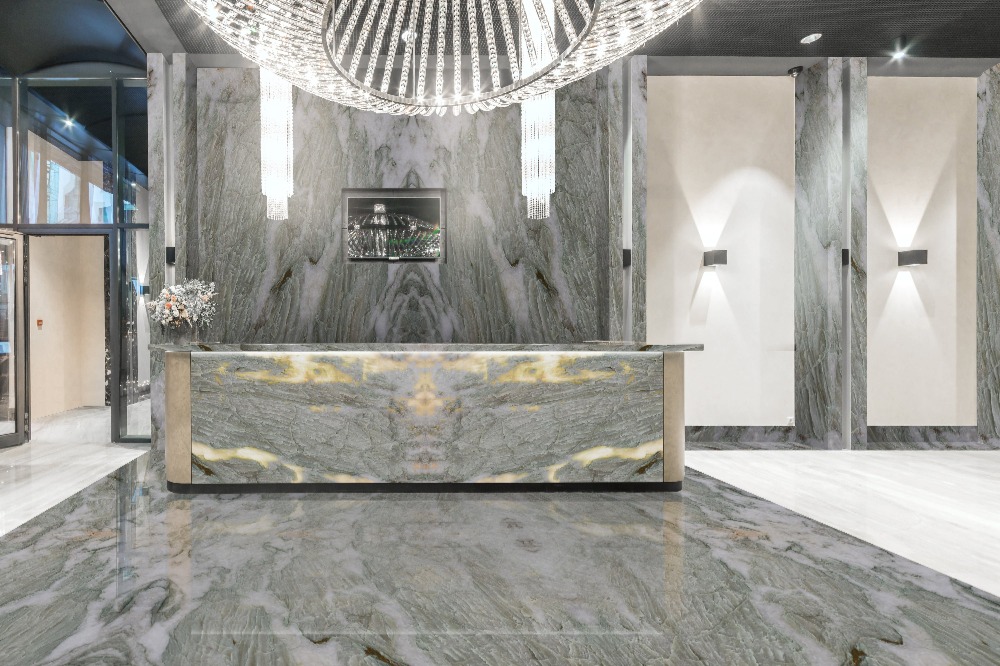
Quartzite can seem more elusive than some of its popular stone counterparts like granite or marble, but this excellent surface material shouldn’t be overlooked! In this post, Cosmos SurfacesTM answers questions like “Is quartzite a natural stone?” We’ll also explain its properties, best uses and maintenance requirements.
Is Quartzite a Natural Stone?
Yes! Quartzite is a metamorphic rock, which means it started out as one kind of stone—in this case, sandstone—and then it changed into a new kind of stone due to prolonged exposure to heat and pressure below the Earth’s surface. Depending on how intense that heat and pressure gets, quartzite may exist on a spectrum. Lightly metamorphosed quartzite sometimes retains a “grainy” quality (a feature left over from its parent rock, sandstone). Crystalline quartzite is less grainy and less porous. You can learn more about how quartzite is formed in our blog post explaining different types of quartzite.
What’s the difference between Quartzite and Quartz?
Quartzite and quartz are often confused, but they are two different surface materials. While quartzite is a natural stone, quartz surface products are an engineered, manmade material. Both products contain natural quartz minerals, but manmade quartz surfaces are manufactured through a process where the minerals are ground up and fused with binders like resin. By adding pigments and manipulating the process along the way, quartz countertops can be made in a variety of colors and can mimic the look of natural stones like marble.
While both materials are considered very durable, natural quartzite stands up well to the elements, while engineered quartz is more sensitive to heat and sunlight. This makes natural quartzite suitable for a range of uses, including outdoor applications, while engineered quartz is best kept indoors, as prolonged exposure to heat and sunlight can cause warping or cracking. Lastly, engineered quartz is made to be non-porous and never needs to be sealed, while natural quartzite might require occasional sealing.
What are the Best Uses of Quartzite?
Owing to its incredible durability and resistance to heat, quartzite is a versatile material that works wonderfully in high-traffic areas like kitchen countertops. Quartzite is suitable for a range of applications, from flooring and walling to fireplace surrounds. The stone also stands up well to the elements and can be used for outdoor applications like patio flooring, pool decks and stair treads. This makes it possible to create a seamless, flowing look from the inside of your home to the outside.
Can You Scratch or Etch Quartzite?
Quartzite is twice as hard as glass and harder than the blade of a knife—it’s just about indestructible! These properties make it an excellent choice for surfaces that are subject to everyday wear and tear, such as kitchen countertops. In fact, quartzite is so strong, it can dull your knives! It is, in any event, wise to avoid using sharp utensils directly on countertops. While true quartzite itself is not likely to show scratches or etching, the sealant on top will take on and show damage.
Does Quartzite Need to be Sealed?
Most fabricators will apply a sealant before installation and explain any additional sealing that needs to happen over the life of the quartzite. In general, depending on the sealer, quartzite needs to be sealed at least once every 10 years. A tell-tale sign that it’s time to seal or re-seal a quartzite countertop is when the surface gets darker around wet areas, like sinks. If you are uncertain, you can test its porosity yourself by leaving a small amount of hot water on the surface for roughly 20 minutes, then wiping it away. If a darkened spot remains, your surface is soaking up liquid and could likely benefit from a sealant. Sealing a quartzite surface is the key to easy maintenance—be sure to follow the instructions for your specific sealer.
Does Quartzite Stain?
Because quartzites are formed naturally, some are more porous than others. A porous stone is more prone to soaking up liquids and staining. The porosity of quartzite depends on the amount of metamorphosis the stone undergoes as it is formed. The higher the levels of heat, pressure and metamorphosis during formation, the less porous the resulting quartzite will be. To solve the problem of porosity, natural stone surfaces are sealed, which makes cleaning easy and straightforward.
How do You Clean Quartzite?
When it comes to cleaning quartzite, a mild detergent and soft cloth will do the trick in most cases. Avoid using heavy-duty scouring pads, abrasive cleaners, or bleach on quartzite or any other natural stone. Be sure to clean spills right away, especially acidic spills (lemon juice, vinegar, wine, etc.) and food coloring agents (turmeric, food dyes, etc.).
A Note on True Quartzite
Due to similarities in appearance, softer stones can be mislabeled as quartzite or “soft quartzite” when it’s actually an intermediate quartzite, sandstone, marble, or dolomitic marble. True quartzite is incredibly strong, does not etch and cannot easily be scratched by a knife blade. It’s wise to double check with your supplier to ensure you are getting true quartzite.
Conclusion
If you have more questions or if you’re looking for quartzite suppliers, we’d love to hear from you. Cosmos SurfacesTM brings over three decades of knowledge and industry experience to the table. Get in touch by filling out our contact form today!
Color of the Month: Lava Blue
This month’s featured trending color is Lava Blue! Neutral, dark blue with violet undertones calls to mind the power and beauty of the Earth’s natural forces. Pair with white or off-white to create a stunning accent wall, or design your foyer or dining room with this rich, welcoming blue in mind.

The blue-gray background and thick, crystalline bands of white resemble a wintry wood in the type of quartzite we’ve dubbed Cassini. Also known as Vogue Blue or Paramount, Cassini paints a striking scene. Cassini is a cool and boldly unique choice for any modern space, including kitchens, bathrooms, and living rooms. Quartzite is resistant to scratching, staining, and fading, and the beauty is unmatched.












